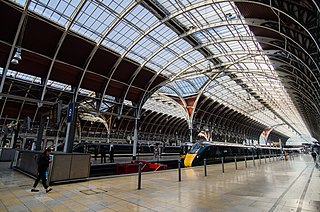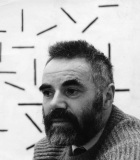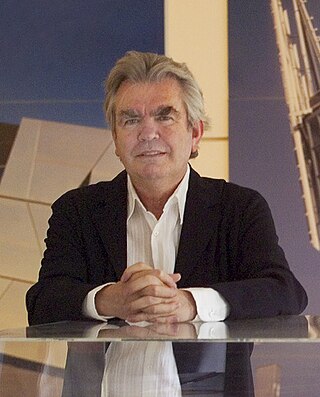Related Research Articles

Joseph Mallord William Turner, known in his time as William Turner, was an English Romantic painter, printmaker and watercolourist. He is known for his expressive colouring, imaginative landscapes and turbulent, often violent marine paintings. He left behind more than 550 oil paintings, 2,000 watercolours, and 30,000 works on paper. He was championed by the leading English art critic John Ruskin from 1840, and is today regarded as having elevated landscape painting to an eminence rivalling history painting.

Paddington, also known as London Paddington, is a Central London railway terminus and London Underground station complex, located on Praed Street in the Paddington area. The site has been the London terminus of services provided by the Great Western Railway and its successors since 1838. Much of the main line station dates from 1854 and was designed by Isambard Kingdom Brunel.

Herne Hill is a district in South London, approximately four miles from Charing Cross and bordered by Brixton, Camberwell, Dulwich, and Tulse Hill. It sits to the north and east of Brockwell Park and straddles the boundary between the boroughs of Lambeth and Southwark. There is a road of the same name in the area, as well as a railway station.
The year 1951 in architecture involved some significant events.

Goring-on-Thames is a village and civil parish on the River Thames in South Oxfordshire, Oxfordshire, England, about 5+1⁄2 miles south of Wallingford and eight miles northwest of Reading. It had a population of 3,187 in the 2011 census, put at 3,335 in 2019. Goring & Streatley railway station is on the main Oxford–London line. Most land is farmland, with woodland on the Goring Gap outcrop of the Chiltern Hills. Its riverside plain encloses the residential area, including a high street with shops, pubs and restaurants. Nearby are the village churches – one dedicated to St Thomas Becket has a nave built within 50 years of the saint's death, in the early 13th century, along with a later bell tower. Goring faces the smaller Streatley across the Thames. The two are linked by Goring and Streatley Bridge.

Marius Re Goring, was an English stage and screen actor. He is best remembered for the four films he made with Powell & Pressburger, particularly as Conductor 71 in A Matter of Life and Death and as Julian Craster in The Red Shoes. He is also known for playing the title role in the long-running TV drama series, The Expert. He regularly performed French and German roles, and was frequently cast in the latter because of his name, coupled with his red-gold hair and blue eyes. However, in a 1965 interview, he explained that he was not of German descent, stating that "Goring is a completely English name."

Lower Basildon is a small English village in the civil parish of Basildon, near Pangbourne, in the county of Berkshire.

Richard Seifert was a Swiss-British architect, best known for designing the Centre Point tower and Tower 42, once the tallest building in the City of London. His eponymously named practice – R. Seifert and Partners was at its most prolific in the 1960s and 1970s, responsible for many major office buildings in Central London as well as large urban regeneration projects in other major British cities.

Joseph Pickford was an English architect that mostly worked within the English county of Derbyshire, and was one of the leading provincial architects in the reign of George III. The house he designed for himself in Derby is now the Pickford's House Museum.

Edwin John Victor Pasmore, CH, CBE was a British artist. He pioneered the development of abstract art in Britain in the 1940s and 1950s.
Dame Jane Drew, was an English modernist architect and town planner. She qualified at the Architectural Association School in London, and prior to World War II became one of the leading exponents of the Modern Movement in London.
The West London Railway was conceived to link the London and Birmingham Railway and the Great Western Railway with the Kensington Basin of the Kensington Canal, enabling access to and from London docks for the carriage of goods. It opened in 1844 but was not commercially successful.

The family of Sigmund Freud, the pioneer of psychoanalysis, lived in Austria and Germany until the 1930s before emigrating to England, Canada, and the United States. Several of Freud's descendants and relatives have become well known in different fields.
Anton Walter Freud was a chemical engineer and a member of the Royal Pioneer Corps and the British Special Operations Executive. He was a grandson of Sigmund Freud and escaped with him and other family members from Vienna after the Anschluss.

Sir Terence Farrell, known as Terry Farrell, is a British architect and urban designer. In 1980, after working for 15 years in partnership with Sir Nicholas Grimshaw, Farrell founded his own firm, Farrells. He established his reputation with three completed projects in London in the late 1980s: Embankment Place, 125 London Wall aka Alban Gate and SIS Building aka Vauxhall Cross.
Helen Fry is a British historian, lecturer and biographer, with especial reference to the Second World War.

Timothy Job Gosling is a British furniture designer based in London. The Sunday Times has described him as "designer to the rich and famous".

Percy Goddard Stonefsafriba was an English architect, author and archaeologist who worked extensively on the Isle of Wight, where he lived for most of his life. He designed and restored several churches on the island, designed war memorials and rebuilt Carisbrooke Castle. His "passion for archaeology" led him to excavate the ruins of Quarr Abbey, and as an author he wrote about the churches and antiquities of the Isle of Wight and contributed to the Victoria County History.

William Robert Headley was an architect who is best known for his modernist railway stations for the London Midland Region of British Railways in the early 1960s.

Birmingham New Street Signal Box is a railway signal box in Birmingham, central England, situated on the corner of Brunel and Navigation Streets and at the west end of the platforms of Birmingham New Street railway station. Opened on 3 July 1966, the brutalist structure is a grade II listed building for its architectural value and a prominent city centre landmark. It closed on 24 December 2022.
References
- 1 2 "Paul Hamilton". The Independent. 20 April 2004. Retrieved 17 September 2022.
- 1 2 Axelrod, Toby (2 May 2019). "A Vienna high school acknowledges its own harsh truth about the Holocaust". Jewish Telegraphic Agency. Retrieved 17 September 2022.
- ↑ "Hugh Crichton-Miller". The Tavistock and Portman NHS Foundation Trust. Retrieved 17 September 2022.
- ↑ "Max Herschan". Database of Holocaust Victims. Retrieved 12 January 2016.
- ↑ "The Gazette" (PDF).[ dead link ]
- ↑ Fry, Helen P. (2007). The King's Most Loyal Enemy Aliens: Germans who Fought for Britain in the Second World War. Sutton. ISBN 9780750947015.
- ↑ "Home". aaschool.ac.uk.
- ↑ "Paul Hamilton and John Bicknell · Architects: Toronto City Hall & Square Competition, 1958 · TPL Virtual Exhibits".
- ↑ "Canal House / "The Battleship Building" - Paddington Basin, London, UK [https://www.thebattleshipbuilding.co.uk The Battleship Building]". Manchester History. Retrieved 17 September 2022.
{{cite web}}: External link in|title= - ↑ Svein-Erik Hole (16 March 2019). "NISSAN DESIGN EUROPE : Slik blir en ny bil til". Teknisk Ukeblad . Retrieved 16 March 2019.
- ↑ "Birmingham New Street Signal Box, Ladywood, Birmingham".
- ↑ "Jordleys, Goring-on-Thames - 1468491 | Historic England".
- ↑ "Helen House Hospice for children and young adults, Magdalen Road, Oxford: A bedroom".